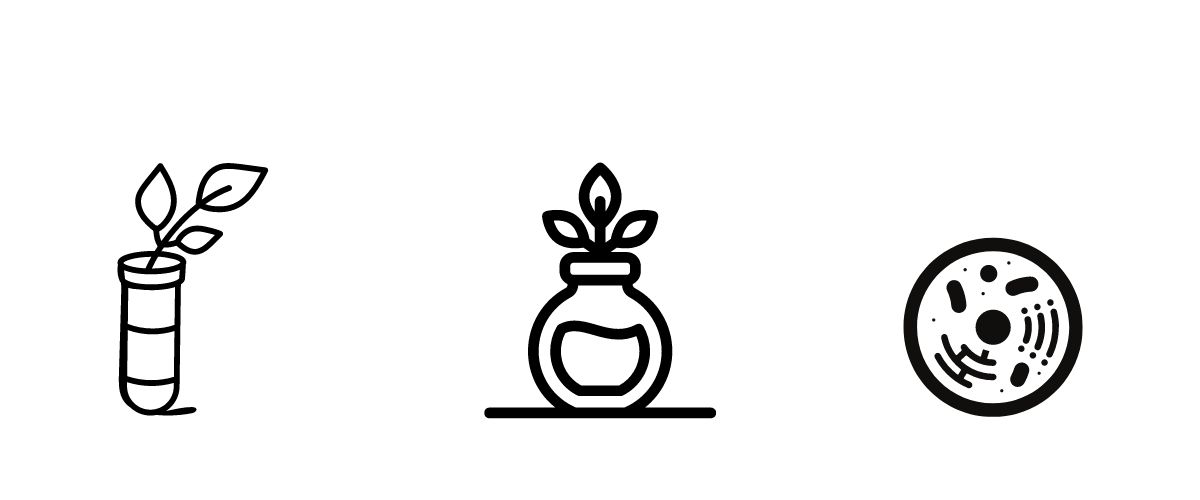
If you are in the process of designing a tissue culture lab, there are a number of key factors you will need to consider. Here at OnePointe Solutions, we specialize in helping clients from virtually every industry to design and build custom laboratory solutions that fit their exact needs and have partnered with countless manufacturers, researchers, designers, and experts to create some of the best labs in the country.
Here, we’re sharing a few basic tips for what to consider when designing a tissue culture lab and offering our advice for the best solutions to common tissue culture lab needs.
What Is A Tissue Culture Lab?
A tissue culture lab is a building or room in which tissue fragments from a plant, animal, or other organism are transferred to an artificial environment in which they can survive, function, and grow. These tissues are propagated for several biological research purposes. These type of facilities need quality cabinet storage like stainless steel cabinets or powder-coated metal cabinets.
Plant Tissue Culture Versus Animal Tissue Culture
Both plant and animal tissue can be cultured in a lab. However, the purposes of propagation are different for these two types of tissue.
Plant tissue culture labs can propagate plants or plant parts for research, but there is a growing market for cultured plants in general. Plant tissue culture is a process that puts plant material in a growing medium to grow new plants.
The initial plant material is cultured and developed in a specific and tightly controlled environment. This process allows you to grow multiple identical plants in quick succession.
This process is useful for research but is also useful for farmers and other growers looking to increase crop yield and businesses looking to produce exact replicas of a plant strain for profit.
Animal tissue culture labs propagate tissues for research. This can include growing muscle and organ tissues for medical research, as well as culturing individual cell lines that can be transformed to grow indefinitely.
Cell cultures are necessary for much of today’s medical and other biological research, as the ability to test things on large groups of identical organisms or organism parts allows for greater control and better comparisons between results.
Whatever type of tissue you plan to culture, there are certain laboratory characteristics that you need to meet. OnePointe Solutions has designed numerous tissue culture labs and can help you put together the ideal lab for any kind of tissue culture.
Ideal Lab Location
Many larger tissue culture labs are built-in standalone buildings. However, space in an existing building can also be converted to a tissue culture laboratory.
The ideal laboratory location meets the following criteria:
- Isolated from foot traffic in a quiet, out-of-the-way area
- No contamination from adjacent rooms
- Thermostatically controlled heat
- Access to water and drains for a sink
- Adequate electrical service
- Good lighting
- Provisions for a fan and intake blower for ventilation
Modifying your existing space for a lab is quite possible, and whether you’re starting from scratch or planning to renovate, OnePointe Solutions has the experience and lab design team necessary to complete any lab building project. As shown in our work designing agricultural and seed labs, we are well-versed in the design language of a lab designed for growth and propagation, and we are happy to help turn your space into a functional tissue culture laboratory.
Lab Areas
While your lab setup is highly customizable based on your needs, all tissue culture labs have certain requirements for lab design. Regardless of the lab’s specific purpose, you will need to have the following basic facilities: a general washing area, a media preparation, sterilization, and storage area, an aseptic transfer area, environmentally controlled incubators or culture rooms, and an observation and data collection area.
The traffic pattern and workflow in a tissue culture lab must be considered to maximize cleanliness. The culture room and the aseptic transfer area must be the two cleanest areas in your tissue culture laboratory, so it is best to design these rooms so they are not entered directly from the outside of a building.
The media preparation area, general washing area, storage areas, and observation and data collection areas should be located outside these rooms.
The primary growth room and aseptic transfer room should be enclosed with doors leading to each. Traffic through these areas can be minimized by installing pass-through windows.
Ideally, the media preparation area would lead to the sterilization area, which would lead to the aseptic transfer room and eventually the primary growth room.
General Washing Area
Your general washing area should contain large sinks, with at least one being lead-lined to resist harsh acids and alkalis. You will also need draining boards and racks and have access to different types of filtered water.
This includes distilled water, double-distilled water, and demineralized water. You should also prioritize space for drying ovens or racks, automated dishwashers, acid baths, pipette washers and dryers, and storage cabinets.
Media Preparation, Sterilization, and Storage Area
Your media preparation area requires ample lab storage space for the chemicals, culture vessels, and glassware required for media preparation and dispensing. Media preparation requires numerous tools, like hot plates and stirrers, pH meters, balances, water baths, dispensing equipment, air and vacuum sources, gas sources for Bunsen burners, and other small equipment that requires bench space in addition to your laboratory worktop and bench workspace.
You will also require dedicated temperature-controlled storage, like refrigerators and freezers for storing stock solutions and chemicals, and you may need a microwave or convection oven. Finally, this space also requires sterilization tools.
Domestic pressure cookers can be used to sterilize instruments and glassware, but an autoclave has a greater capacity than a pressure cooker and can sterilize more objects at once.
Aseptic Transfer Area
The aseptic transfer area should be a separate room to decrease spore circulation and the potential for contamination. This room must be as clean as possible, and lab personnel should wear lab coats and shoe coverings to maintain sterility. Laminar flow hoods or biosafety cabinets are required to prevent contamination.
Some tissue culture labs include ultraviolet lights to disinfect the room; however, these must not be the only light source and should actually be turned off when people or plant material are in the room, as too much ultraviolet radiation can damage living tissue. The aseptic transfer area also must have enough outlets to accommodate bench appliances such as balances, flow hoods, and microscopes.
Incubators and Culture Rooms
The incubator or culture room is one of the most important parts of any tissue culture laboratory, as this is where the tissue growth takes place. This area is also highly customizable depending on what your lab’s research or growth focus is.
All types of tissue cultures should be incubated under tightly controlled temperature, humidity, air circulation, and light quality and duration conditions. These environmental factors will influence your growth process directly during culture, or indirectly by affecting the tissues’ response in subsequent generations.
Without the ability to control every factor of your developing tissues’ environment, you will not be able to maintain control over the tissues’ development.
Typically, the culture room for the growth of tissue cultures should have a temperature between 15°-30°C with a temperature fluctuation of less than ±0.5°C. A reliable, precise thermostat is required to maintain this level of temperature control.
Temperature is the primary concern in culture rooms, as it affects decisions related to lighting, relative humidity, and shelving.
While some tissue cultures can be kept in darkness, most culture rooms are lit. For plant tissue culturing, your culture room should have cool white fluorescent lights for the first stages of growth and broad-spectrum light (which helps encourage rooting) for the later stages of growth.
Fans can help with any additional heat or condensation created by your lights.
Condensation caused by lighting can also affect humidity, which you also need to control in the culture room. The culture room should have fairly uniform forced-air ventilation and a humidity range of 20-98% controllable to ±3 percent.
Fluctuations in the humidity can damage your tissues, so you will need to monitor and control this with humidifiers or dehumidifiers.
Finally, you need to consider shelving units. Different types of shelving units are available for different culture operations, and you need to consider material, size, and spacing.
Particleboard or plywood can be used for inexpensive shelving; expanded metal is an option that is more expensive but promotes air circulation. Tempered glass can be used to increase light penetration, but it is prone to breakage.
To take the guesswork out of your shelving needs, contact OnePointe Solutions about your custom lab shelving needs. Our representatives can help you with any lab shelving questions you may have.
For some tissue culture labs, a full room with one set of controls might not be the optimal culture room environment. Walk-in growth chambers or smaller incubators and environmental cabinets offer a smaller culture space with tight controls that allow you to maintain different environmental parameters in each space.
Depending on the amount of tissue you plan to culture, a room with several smaller incubator options might be better for your lab.
Observation and Data Collection
Your observation and data collection area can be a separate room, or you can have observation setups in various locations in your lab. The design and contents of these areas will vary widely based on your lab’s needs, but generally, they will include lab workstations where your technicians and scientists have access to computers for recording and bench space for experimentation.
Microscope tables and other specialized equipment are often found in these spaces.
Safety Precautions
Tissue culture lab work may include volatile chemicals, so you will need to install fume hoods, HEPA filters, and at least one lead-lined sink. Your tissue culture lab will draw a lot of power, and most wiring will require 110 volts.
Having your lab’s wiring done by professional electricians is an absolute must. An emergency generator should be available to operate essential equipment during power outages.
Lab Equipment
The equipment needed for a tissue culture lab is complex and often must be made custom to your lab’s specifications. While units like eyewash stations, drying racks, and sinks can be purchased and installed outright, casework and cabinetry, as well as your lab countertops, may need to be manufactured to spec.
At OnePointe Solutions, we are experts at building custom casework, countertops, lab tables, fume hoods, and other lab furniture and equipment that will improve your lab’s workflow and efficiency. The time and expense of customizing your lab equipment is worth it; with lab furniture that’s designed specifically for your lab’s needs, your lab’s operations will run smoothly and you will be able to feel secure and satisfied knowing that everything in your lab is top of the line and guaranteed to perform beyond expectations.
OnePointe Solutions is a leading laboratory construction and design firm, scientific furniture manufacturer, and lab builder. Our project history ranges from classrooms to Biosafety Level 3 and 3+ enhanced labs.
No lab project is too small or too large for our expert design team. Contact us to get an estimate on furniture or full lab design and renovation today!
Need Help With Your Tissue Culture Lab?
If you’re a scientist or engineer in a tissue culture lab or a general contractor building one, we can help you furnish your articulate space to make sure testing and processes are not hindered. From technical lab equipment like fume hoods and biosafety cabinets to more standard items like stainless steel cabinets for storage and epoxy or phenolic resin countertops for work surfaces.
We have a plethora of lab furniture options to choose from including small items like drying racks, sinks, and pegboards too. Give ys a call at 866-222-7494 to speak to a lab specialist today!


